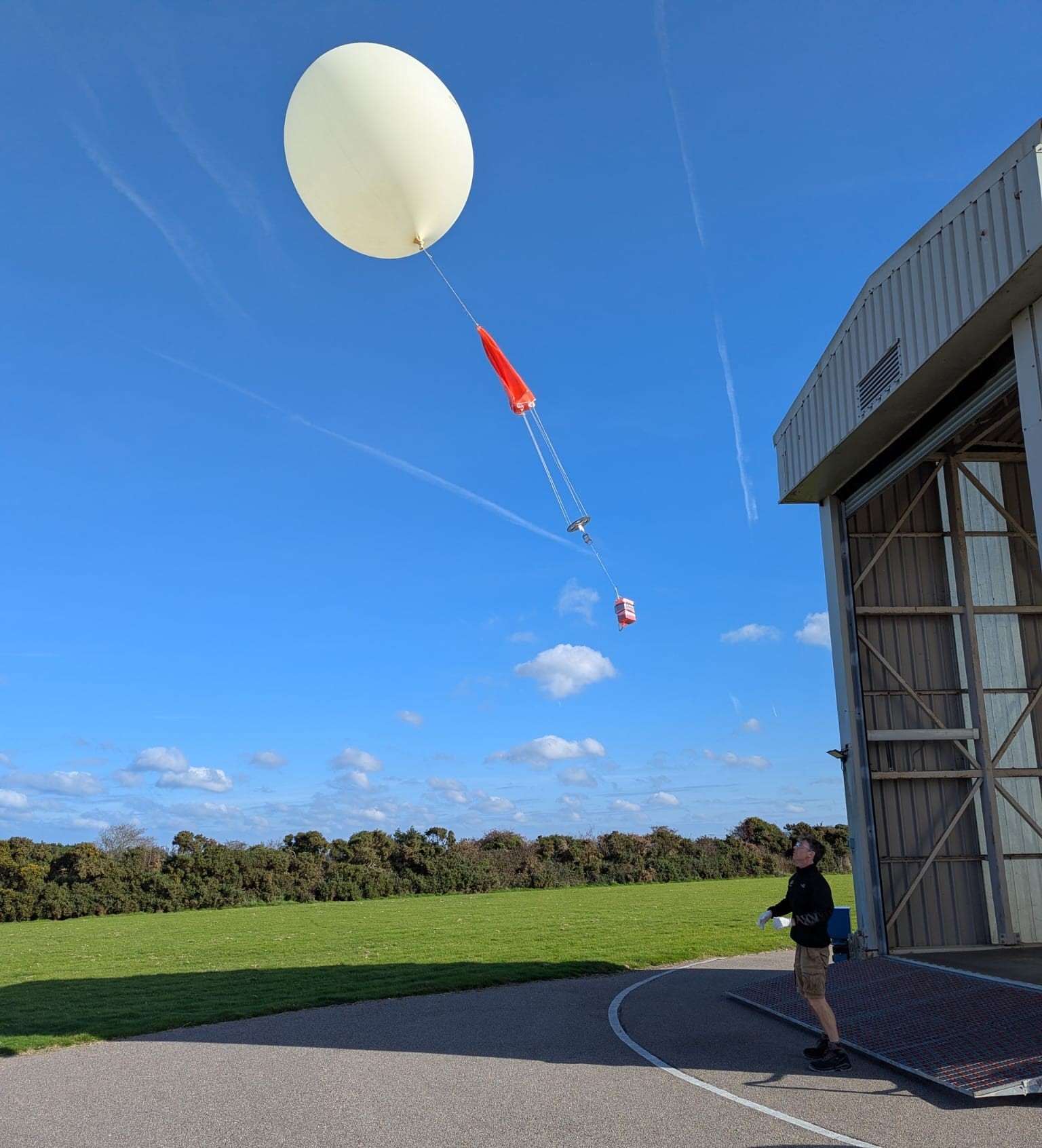Leap forward for space weather monitoring
Author: Press Office
08:22 (UTC+1) on Mon 20 Oct 2025
Scientists have launched the first batch of a novel type of radiation monitor into the atmosphere as part of an innovative project to enhance space weather models and deepen scientific understanding of the impact of space weather.
Launches of radiation monitors took place concurrently on 17 October at Met Office sites in Camborne and Lerwick in the UK, as well as at De Bilt in the Netherlands operated by Dutch forecasters KNMI.
The monitors, developed by the University of Surrey, were attached to weather observation balloons and released from ground level to go up more than 100,000 feet, capturing live observations of radiation levels as they travelled through the Earth’s atmosphere and towards the stratosphere.
This initial launch was a proof-of-concept, monitoring background radiation levels through the atmosphere and comparing with existing ground-based monitoring equipment which was installed earlier this year at Camborne.
Future launches will take place during space weather events to further enhance radiation models and improve understanding of how space weather influences radiation levels from high in the atmosphere to ground level.
Met Office Senior Space Weather Manager Krista Hammond was present at the first launch in Camborne and explained how the project will aid Met Office operations. She said: “Space weather monitoring is in its infancy compared to meteorology, so this project will provide a huge leap forward in terms of our understanding of how space weather events impact radiation levels through the Earth’s atmosphere.
“Data from these launches will be used to validate and improve existing radiation models that we use, which is important for a range of industries that can be influenced by space weather, including aviation, energy and other ground-based infrastructure.”

The new sensor was placed on a weather balloon to collect data as part of the flight. (Image: Ben Clewer, University of Surrey)
Similar radiation monitors, also developed by the University of Surrey as part of the Space Weather Instrumentation, Measurement, Modelling and Risk (SWIMMR) programme, are already in use on some commercial airlines, providing data at cruising height.
Professor Keith Ryden, Director of the Surrey Space Centre at the University of Surrey, said: “We’re absolutely delighted to participate in this first international launch of our new SAIRA-B space weather radiation probes on Met Office and KNMI balloons. This is a highly compact detector our team has developed based on SAIRA-A, which we and the Met Office already fly on several aircraft. We’ve actually been doing these kinds of measurements for a long time – our very first instrument flew on Concorde back in the 1980s and recorded several space weather events.
“With SAIRA-B, we now have an even lighter system designed for rapid balloon launches, reaching altitudes more than twice that of typical commercial aircraft levels – giving us a new way of tracking radiation levels through the atmosphere.”
The data will be used to further enhance the MAIRE+ model for modelling radiation levels, which has been developed by the University of Surrey and is currently undergoing testing, validation and refinement at the Met Office Space Weather Operations Centre.
Cross-border space weather impacts
The potential impacts of space weather crosses borders, which is why this project is including radiation monitor launches not only from Met Office sites in Camborne and Lerwick, but also in the Netherlands, thanks to Netherlands-based forecasters KNMI.
A wider range of data points will allow more detailed analysis of radiation levels during space weather events. For example, a higher latitude site like Lerwick should expect different impacts to those further south, like at Camborne and in De Bilt.
Maarten van Aalst, Director General for Netherland-based forecasters KNMI said: “This coordinated balloon launch with the Met Office is a great example of how international collaboration can enhance our shared research and development, ultimately improving services - such as providing the aviation sector with warnings about the adverse effects of space weather.”
The project is part of the SWIMMR programme, funded by the UK government and managed by the Science and Technology Facilities Council, which was a long-term project to improve the UK’s space weather forecasting capabilities. SWIMMR, which stands for Space Weather Instrumentation, Measurement, Modelling and Risk, has been vital for UK forecasting and preparedness in recent years, funding projects around hazard mitigation, GPS protect and innovative research projects.
Professor Ian McCrea, SWIMMR programme lead at STFC RAL Space, said: “It is very pleasing to see these launches happening, especially with the international collaborative element involving our Dutch partners. This work combines two SWIMMR instrument development projects by coordinating balloon-borne radiation sensors with ground-based neutron monitors.
“Learning how to use these instruments together is an important step towards validating SWIMMR’s atmospheric radiation models. The results will contribute to broader monitoring and prediction capabilities for radiation effects on aviation, demonstrating how SWIMMR’s multiple components work together to deliver an integrated space weather capability for the UK.”
A recent Value Report suggested that the Met Office’s space weather capability will be worth around £600million to the UK energy industry alone over the next decade, underlining the importance of timely, accurate and authoritative space weather forecasts and information.


